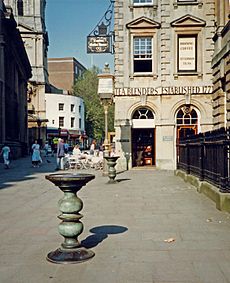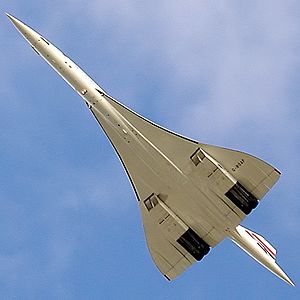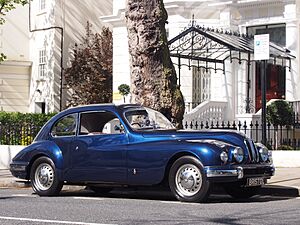Economy of Bristol facts for kids
Bristol is a big city in the southwest of England. For a long time, its economy has been closely linked to the sea and its busy ports. In the 1900s, making airplanes became very important for the city's economy. Even today, Bristol still plays a big part in building aircraft. Bristol is also a popular place for tourists to visit. It has important businesses in media, computer technology, and money services. Reports from 2018 showed that the city is growing fast. It was expected to grow by 2.3 percent each year until 2020.
Contents
Bristol's Story
Bristol has a long history of trading. At first, it sent out wool cloth and brought in fish, wine, grain, and milk products. Later, it imported things like tobacco, tropical fruits, and goods from plantations. Today, major imports include cars, grain, wood, fresh food, and oil products.
Since the 1200s, the rivers in Bristol have been changed to make docks for ships. In the 1240s, a river called the Frome was moved into a deep, human-made channel. This channel was called Saint Augustine's Reach. It flowed into the River Avon, making it easier for ships to dock.
Ships from Bristol sometimes sailed to Iceland as early as 1420. Some people even think that sailors from Bristol might have landed in the Americas before famous explorers like Christopher Columbus or John Cabot. These sailors were likely fishermen who landed on the Canadian coast to salt and smoke their fish. In the early 1480s, a group called the Bristol Society of Merchant Venturers helped pay for trips to explore the North Atlantic. They were looking for new trading chances. In 1552, King Edward VI gave the Merchant Venturers a special permission. This allowed them to manage the port.
After Cabot, other explorers also left from Bristol's port. These included Martin Frobisher and Thomas James. James Bay, on the southern coast of Hudson Bay, is named after Thomas James. Another explorer was Martin Pring, who found Cape Cod and the southern New England coast in 1603.
By 1670, the city had ships that could carry 6,000 tons of goods. Half of these goods were imported tobacco. Bristol was one of England's main centers for the slave trade. By the early 1700s, this trade made up half of the city's total income. Bristol's share of the slave voyages grew steadily. At its busiest, it handled 70 percent of the slave trips to America. Banks and other money businesses grew to support this trade. Even though the slave trade was stopped a long time ago, these banks continued. This is why Bristol today has one of the highest numbers of finance jobs in the United Kingdom.
When the slave trade ended, Bristol started to become a city that made things. This happened during the Industrial Revolution. However, it didn't grow as fast as other big industrial areas in Britain. In the 1800s, the city's economy slowly went down. By the early 1900s, it was the 10th largest city in Britain. The economy started to get better after this time. This was especially true after some economic changes, like how the port was managed. Industries like cotton, tobacco, and chocolate making, as well as shipbuilding, began to do well.
How Bristol Makes Money
Bristol's economy did quite well during the Great Recession of 2008–2010. It kept growing while most other cities saw their economies shrink. However, in 2011, the economy got smaller by 3.1%. While Bristol's economy is now getting better, it is still a little bit behind its best performance in 2010.
Compared to other big cities, Bristol has a high amount of money made per person. This is called GVA per head. It is the highest among the main "Core Cities" in the UK. Overall, it is the fifth highest in the United Kingdom, after London, Edinburgh, Belfast, and Glasgow.
Jobs in Bristol
In 2000, Bristol's unemployment rate was 5.9%. This was similar to the average for England and the United Kingdom. By 2005, it had gone down to 5.2%. Recent numbers show that the South West region, where Bristol is located, has a high employment rate of 79.4 percent. This is higher than the rest of the country, including big cities like London.
Making Airplanes
In the 1900s, Bristol started making airplanes at a place called Filton. This is about six miles (10 km) north of the city center. The Bristol Aeroplane Company made aircraft, and Bristol Aero Engines (later Rolls-Royce) made airplane engines.
The airplane company became famous for planes like the World War I Bristol Fighter. During the Second World War, they made the Blenheim and Beaufighter aircraft. In the 1950s, it became one of the country's main makers of planes for passengers. They built planes like the Bristol Freighter, Britannia, and the huge Brabazon airliner.
In the 1960s, Filton played a very important part in building the Concorde. This was a special plane that could fly faster than the speed of sound. Parts for Concorde were made in factories in Britain and France. Then, they were sent to two main assembly plants. One was in Toulouse, France, and the other was in Filton, Britain. A very large hangar, built for the Bristol Brabazon plane, was used for making Concorde.
The French made the middle part of the plane and the center wing. The British made the nose, the back part of the plane, the tail fin, and the wingtips. A big part of the British work was on the engines. These were the Rolls-Royce/Snecma 593 engines. The engines were made by British Aircraft Corporation, Rolls-Royce (in Filton), and SNECMA in France.
The British Concorde test plane, called G-BSST, made its first flight from Filton on April 9, 1969. It flew for 22 minutes to RAF Fairford. The French test plane had flown from Toulouse five weeks earlier. Many workers from the airplane companies and a huge crowd watched from around the airfield. Fairford was chosen for testing Concorde because the runway at Filton was not long enough. Also, the first 1000 feet (300 m) of the runway at its eastern end could not be used. However, from late 1977, all test flights for the second production plane, G-BBDG, were done from Filton. This happened after the test base at Fairford closed.
In 2003, the two airlines that used Concorde (British Airways and Air France) decided to stop flying the aircraft. The planes were then sent to different places, mostly museums, around the world. You can find out where all the Concorde planes are by looking up Concorde.
On November 26, 2003, Concorde 216 (G-BOAF) made the very last Concorde flight. It returned to Filton airfield to stay there forever. It will be the main display at a planned air museum. This museum will also include the existing Bristol Aero Collection. This collection used to be in a museum at Kemble Airfield, about forty miles (60 km) from Filton. It includes helicopters and missiles built in Bristol.
Today, the main airplane companies in Bristol are BAE Systems, Airbus, and Rolls-Royce. They are all based at Filton. Another important airplane company in the city is Cameron Balloons. They make hot air balloons. Every August, Bristol hosts the Bristol International Balloon Fiesta. This is one of Europe's biggest hot air balloon events.
Bristol's Port
The Bristol Port Company runs the working docks of the Port of Bristol. These are at Portbury and Avonmouth. Since these docks became private in 1991, trade has grown a lot. Now, 12 million tonnes of goods pass through each year. This makes it the fifteenth largest port in the UK, and the tenth largest in England.
The main things traded are wood products, cars, containers, and bulk goods. Bulk goods include coal, grain, animal feed, and building materials. Liquids like petroleum, aviation fuel, molasses, and fruit juice are also traded. Other goods include metals and fresh food. There are plans to make the port much bigger. They want to build a new deep-sea container terminal. This terminal would be able to handle very large ships.
Film and TV in Bristol
Bristol has been a major production center for the BBC for a long time. The BBC Natural History Unit, famous for its wildlife documentaries, is based there. Bristol is also a base for ITV Wales & West. The Oscar-winning company Aardman Animations, which makes stop-motion films like Wallace and Gromit, started in Bristol in 1972.
In 2010, The Bottle Yard Studios opened in partnership with Bristol City Council. In 2021, these studios were given credit for helping to triple the amount of drama shows made in Bristol since 2010. One of the two new Channel 4 Creative Hubs opened in 2020 in Finzels Reach.
Tobacco Industry
Because Bristol was one of the biggest ports in the UK, it became very important in the tobacco trade. It is still the main office for Imperial Tobacco Group. This is the world's fourth largest international tobacco company. Imperial's main office moved to a new, award-winning building on Winterstoke Road.
Past Industries
Bristol Cars
The Bristol Aeroplane Company started making cars in the 1940s. They built fancy, handmade cars at their factory in Filton. These cars were called Bristol Cars. The car company became separate from the airplane company in 1960. However, the company stopped making cars in March 2011.
Coal Mining
During the 1800s, coal mining was important in parts of Bristol. The coal provided energy for factories. The coal field was part of a large area that stretched from the Somerset coalfield into Gloucestershire. All the coal mines in Bristol have now closed.




